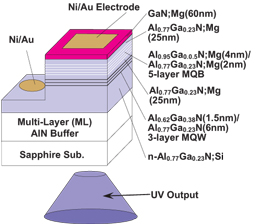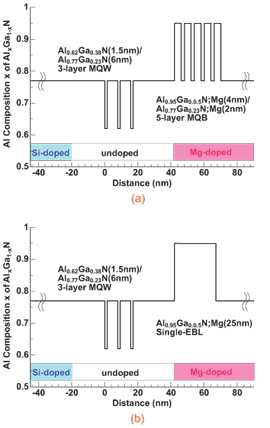
| Home | About Us | Contribute | Bookstore | Advertising | Subscribe for Free NOW! |
| News Archive | Features | Events | Recruitment | Directory |
News
2 March 2010
Multi-quantum blocking raises deep-UV LED efficiency
A 2.7x efficiency enhancement from using multi-quantum barrier (MQB) electron blocking layers (EBLs) is claimed for deep-ultraviolet (DUV) nitride semiconductor light-emitting diodes (LEDs) developed by researchers based in Saitama, Japan [Hideki Hirayama et al, Appl. Phys. Express, vol3, p031002, 2010]. The wavelengths of the devices were in the range 262–250nm.
The maximum external quantum efficiencies and output powers achieved for a 250nm LED in continuous-wave (cw) operation at room temperature were 1.18% and 4.8mW, respectively. Even better performance was achieved at the longer wavelength of 262nm: 1.54% and 10.4mW, respectively.
These characteristics are claimed as “the highest values ever reported” by the researchers affiliated variously with Institute of Physical and Chemical Research (RIKEN), Saitama University and Japan Science and Technology Agency (JSTA) Core Research of Evolutional Science & Technology (CREST) basic research promotion program.
The possible applications for such sub-280nm devices include sterilization, water purification, medicine, and biochemistry.
Electron blocking layers are commonly used in LEDs to avoid overshoot of electrons into the p-type region of the diode. Electrons that reach the p-type region tend to recombine without producing radiation, reducing the possible light output of the device.
Traditional EBLs usually consist of a single layer of material with a large energy bandgap that raises a barrier to electrons moving toward the p-type region. However, because at very short wavelengths large energy bandgaps are already being used for the well structures where the light is produced, the relative effectiveness of the single-layer EBLs is reduced.
Multi-quantum barriers use interference effects from the wave-like behavior of electrons to enhance the barrier. The theoretical proposal for MQBs dates back to 1986 and was applied in the early 1990s to aluminum gallium indium phosphide (GaInP/AlInP) red laser diodes (LDs). For arsenide and phosphide semiconductors, effective barrier heights can be increased by as much as 50%.
 Figure 1: Schematic for 250nm AlGaN MQW LED with a multi-quantum barrier (MQB) electron blocking layer.
Figure 1: Schematic for 250nm AlGaN MQW LED with a multi-quantum barrier (MQB) electron blocking layer.
 Figure 2: Compositions and doping profiles of AlGaN layers used for 250nm AlGaN QW LEDs with MQB (a) and single-barrier EBLs (b).
Figure 2: Compositions and doping profiles of AlGaN layers used for 250nm AlGaN QW LEDs with MQB (a) and single-barrier EBLs (b).
The Saitama researchers used low-pressure metal-organic chemical vapor deposition (LP-MOCVD) to grow their DUV LEDs on aluminum nitride (AlN) on (0001) sapphire templates. The AlN buffer layer was grown using a pulsed-flow multi-layer (ML) method using ammonia as the nitrogen source. This achieves an edge-type dislocation density of less than 7x108/cm2, as estimated through x-ray diffraction rocking-curves.
The aluminum gallium nitride (AlGaN) LED layers were then deposited on this template (Figure 1). The light-emitting region consisted of multi-quantum wells (MQWs). Devices were produced with single- and multi-layer EBLs to show the effect of using MQBs (Figure 2). Both 250nm- and 262nm-emitting devices were produced (Table 1).
Wavelength |
Well |
Barrier/buffer |
MQB |
Max. EQE |
Max. power |
nm |
x |
x |
x |
% |
mW |
250 |
0.62 |
0.77 |
0.95 |
1.18 |
4.8 |
262 |
0.55 |
0.72 |
0.94 |
1.54 |
10.4 |
Table 1: Al composition x of AlxGa1-xN wells, buffer and barrier layers, and MQB, along with maximum external quantum efficiency (EQE) and output power for LEDs with MQB.
The efficiency peaks in the range of 10–15mA current for the shorter 250nm wavelength device. The 262nm LED has a higher current for the efficiency peak of ~30mA that falls off less steeply beyond that, compared with the 250nm emitter. Despite the efficiency fall-off, the output power continues increasing up to nearly 300mA for the 250nm devices (both single and MQB EBLs). Some of the efficiency fall-off will be due to self-heating effects as a result of the cw operation.
See related items:
Improving deep UV emission on aluminum nitride templates
Deep ultraviolet power boost at shorter wavelengths
![]() Search: DUV LEDs MOCVD AlN Sapphire templates AlGaN
Search: DUV LEDs MOCVD AlN Sapphire templates AlGaN
Visit: http://apex.ipap.jp/link?APEX/3/031002
Visit: www.riken.go.jp/engn
Visit: www.saitama-u.ac.jp/kokusai/english
Visit: www.jst.go.jp/EN
Visit: www.jst.go.jp/kisoken/crest/en/index.html
The author Mike Cooke is a freelance technology journalist who has worked in the semiconductor and advanced technology sectors since 1997.